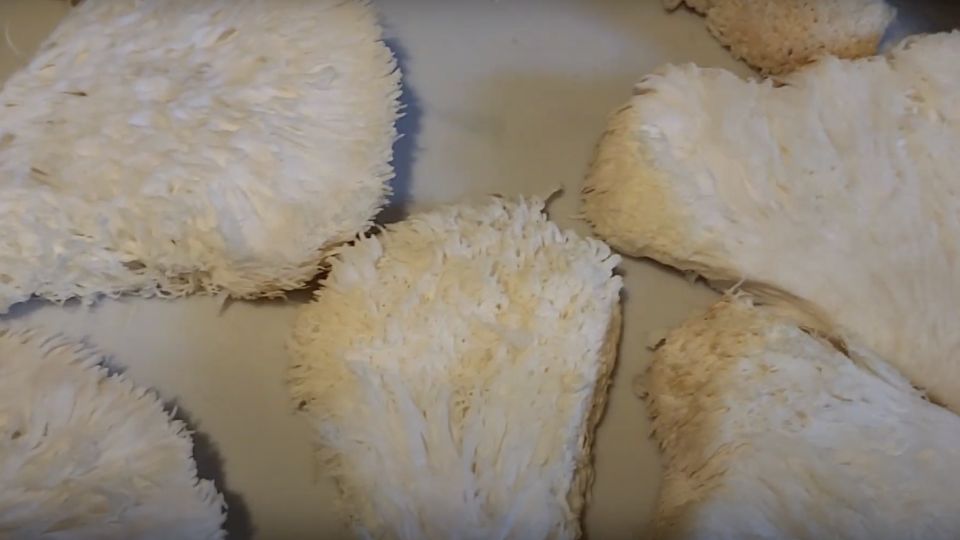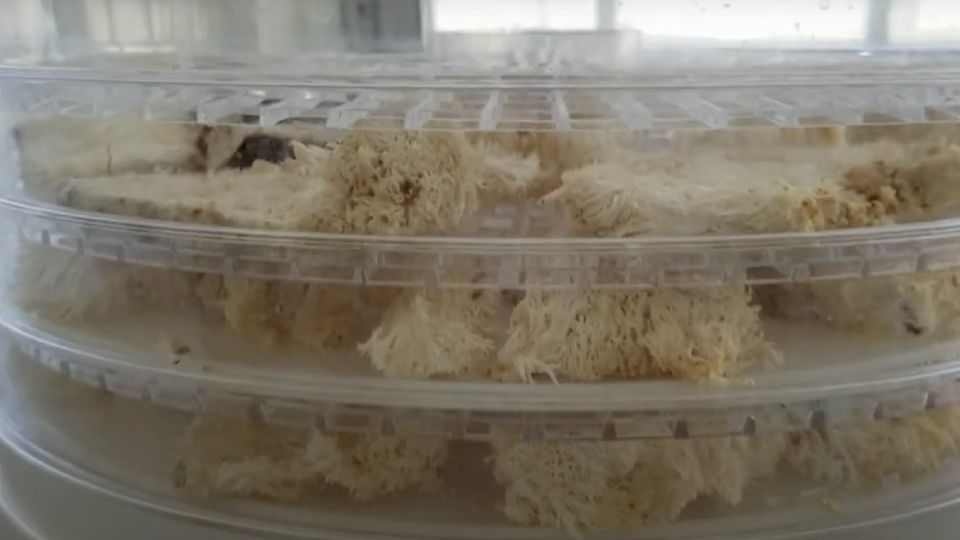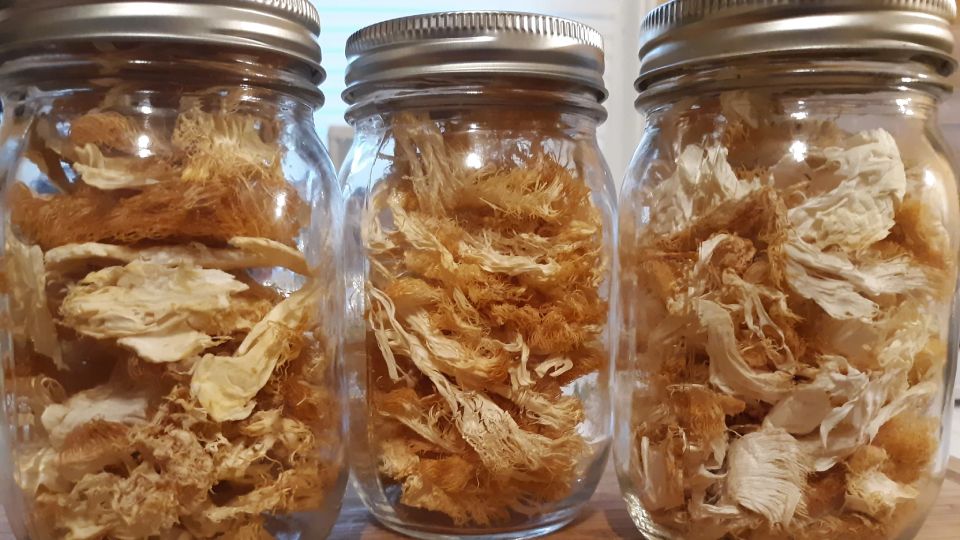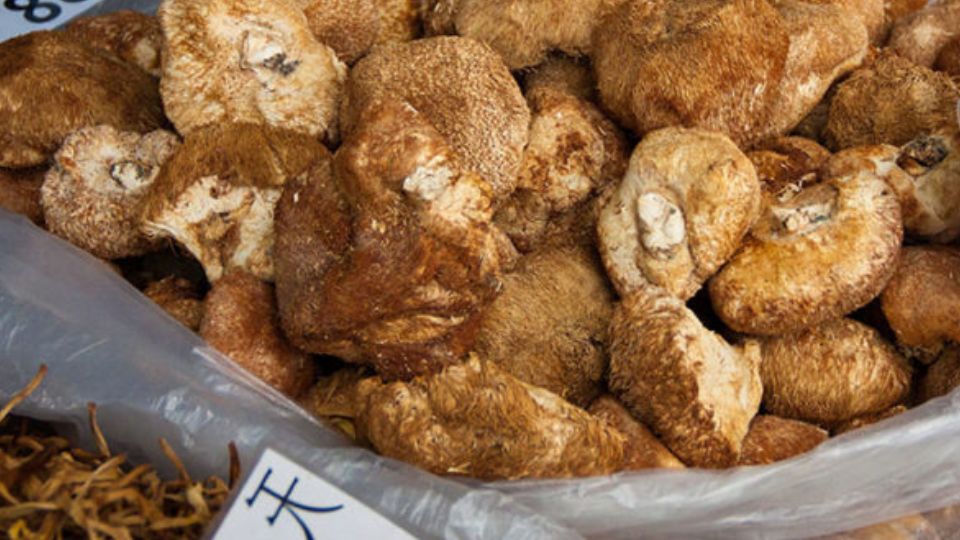How to Dry Lion’s Mane Mushroom: 4 Best Ways
Lion’s Mane, a captivating mushroom, stands out with its distinctive appearance and a treasure trove of health benefits. Its fruiting body boasts a cascade of white spines that mimic a lion’s mane, giving it a fitting name. Fresh Lion’s Mane mushrooms are a treat when lightly fried, but when faced with an excess, dehydrating them becomes an excellent preservation option. Once mushrooms have been dehydrated, you can use them in their whole form or as a versatile powder to enhance a wide range of dishes. They also serve as a valuable supplement in various recipes. You can dry them whole, or if you plan to create extracts powder, you can cut the mushrooms into slices before dying.
If you’re eager to dry the unique and delicious Lion’s Mane mushroom, celebrated for centuries for its exceptional flavor and medicinal qualities, you’re in luck! We’ll guide you through the four best methods we use to dry Lion’s Mane mushrooms. It’s a straightforward process, and we’ll also share the fantastic methods for preserving and storing this remarkable fungus, the tools you’ll need, and some tips for cooking with them.
In this article:
Benefits of Drying Lion’s Mane Mushroom
Drying lion’s mane mushrooms not only preserves their freshness but also concentrates their flavor, making them a versatile ingredient in your culinary adventures. Here are some key benefits of drying them:
- Extended Shelf Life: Dried lion’s mane mushrooms can be stored for an extended period, allowing you to enjoy their unique taste and health benefits throughout the year.
- Intensified Flavor: The drying process enhances the flavor of lion’s mane mushrooms, giving them a rich and earthy taste that can elevate your dishes.
- Space-Efficient Storage: Dried mushrooms take up significantly less space than fresh ones, making them a convenient addition to your pantry.
- Versatility: Once dried, the mushrooms can be rehydrated and used in various recipes, from soups and stews to stir-fries and pasta dishes.
Preparing Lion’s Mane Mushroom for Drying

Before we move on to the drying process, it’s essential to properly prepare the mushrooms:
- Clean the mushrooms using a mushroom brush or a damp paper towel to remove any dirt.
- If you choose to rinse, let them air dry for a couple of hours, preferably in the sunlight to allow excess water to evaporate.
- You can dry lion’s mane mushrooms more effectively by slicing them instead of leaving them whole. Slicing the mushrooms ensures even drying.
- Remove excess water from the mushrooms to expedite the drying process.
How to Dry Lion’s Mane Mushroom
1. Dry Lion’s Mane Mushroom With Oven
Ingredients:
- Fresh lion’s mane mushrooms
- Baking sheet
- Oven
Instructions:
- Preheat your oven to a low temperature, around 150°F (65°C).
- Clean the lion’s mane mushrooms thoroughly, either with a mushroom brush or a damp paper towel, to remove any dirt.
- Slice the mushrooms into uniform pieces.
- Arrange the sliced mushrooms in a single layer on a baking sheet.
- Place the baking sheet in the oven and leave the oven door slightly open to allow moisture to escape.
- Let the mushrooms dry for several hours, and be sure to check them regularly until they become crisp.
- Keep an eye on the slices to prevent over-drying or burning.
- Once they are fully dehydrated, allow the lion’s mane slices to cool, and then store them in airtight containers in a cool, dark place.
2. Dry Lion’s Mane Mushroom With a Dehydrator

Ingredients:
- Fresh lion’s mane mushrooms
- Food dehydrator
Instructions:
- Clean and slice the lion’s mane mushrooms, following the steps mentioned earlier.
- Place the mushroom slices on your food dehydrator trays and set the timer according to the manufacturer’s instructions.
- Set the dehydrator to a low temperature, around 100°F (38°C), and let it run for several hours until the mushrooms are completely dry.
- Keep an eye on the drying process and adjust the time if needed.
- Once the mushrooms are dry, allow them to cool down completely before storing them in airtight containers.
3. How to Dry Lion’s Mane Mushroom With Sun
Ingredients:
- Fresh lion’s mane mushrooms
Instructions:
- Clean and rinse your mushroom.
- Now, slice your mushrooms thinly, about a quarter-inch thick, using a sharp knife. Lay the slices out on a clean, flat surface, ensuring they don’t overlap.
- Cover your mushroom slices with mesh or cheesecloth to protect them from insects and dust.
- Place them in direct sunlight, turning them occasionally to ensure they dry evenly. This will take several hours.
- Once your mushrooms are completely dry, store them in an airtight container in a cool, dry spot.
- If the weather is exceptionally hot and dry, you can even dehydrate the mushrooms outdoors in the sun for maximum vitamin D content.
4. Frizeer Drying Lion’s Mane Mushroom
Ingredients:
- Fresh lion’s mane mushrooms
- Water
- Ice
Instructions:
- Wash and slice the mushrooms. Let them dry out while you prep all the things needed to blanch them.
- Fill a large cooking pot with boiling water, and have another container with ice water prepared. Throw your mushrooms into the boiling water for 90 seconds, then drain or strain them from the boiling water, then submerge them in ice water. This will help preserve their texture and flavor.
- Allow your mushroom slices to dry out. Once the mushrooms are dry and draining, then you can proceed with the freezing portion.
- Pop some parchment paper onto a baking sheet and lay out the lion’s mane mushrooms on the sheet so that they are not touching. Put the tray into the freezer for about an hour until the mushrooms are frozen.
- Once the mushrooms are frozen, remove them from the baking sheet and transfer them to a freezer-safe container or bag. Be sure to label the container or bag with the date.
- Place the container or bag of mushrooms back in the freezer. The mushrooms will be kept for up to 12 months.
How to Store Dried Lion’s Mane Mushroom

After successfully drying your lion’s mane mushrooms, proper storage is crucial to maintain their quality. Follow these steps:
- Place the dried mushrooms in an airtight container or a vacuum-sealed bag.
- Store them in a cool, dry place away from direct sunlight and moisture.
- You can even store them in your freezer for a longer life.
- Label the container with the date of drying for reference.
- Soak in water for 20-30 minutes before cooking to restore texture and flavor.
What is Dry Lion’s Mane Good For?
What we find truly delightful about this distinct mushroom is its seafood-like flavor and hearty texture when cooked. It has earned high esteem in traditional Chinese medicine over centuries, and here’s some of its benefits:
- Cognitive Boost: Lion’s mane is thought to elevate cognitive function, making it a favorite among those aiming to enhance brain health. Some studies even hint at its potential to support the nervous system and possibly assist in managing conditions like Alzheimer’s disease[1].
- Blood Sugar Control: Research indicates that lion’s mane could play a role in lowering blood sugar levels, a boon for individuals dealing with diabetes or striving to maintain healthy blood glucose.
- Anti-Inflammatory Goodness: Packed with compounds that may combat inflammation, the lion’s mane could be your ally in addressing various health issues often linked to inflammation[2].
- Heart-Healthy: Some studies suggest that lion’s mane mushrooms might contribute to heart health by reducing the risk of heart disease and promoting overall cardiovascular well-being.
- Mood Enhancement: Lion’s mane may hold the key to improved mental health by potentially alleviating symptoms of anxiety and depression. While more research is needed, this aspect adds to its allure[3].
Do Fresh Lion’s Mane and Dried Lion’s Mane Taste the Same?
You might wonder if the taste of Lion’s Mane Mushroom remains consistent whether it’s fresh or dried. While both versions keep the signature sweet and earthy flavors, there are some subtle differences.
Fresh Lion’s Mane offers a slightly more pronounced sweetness and a juicier texture, ideal for dishes where its unique taste shines. However, dried Lion’s Mane takes on a concentrated, umami-rich flavor. It’s easy to rehydrate with water, becoming a versatile substitute for fresh mushrooms.
You can also turn dried Lion’s Mane into a powder, expanding its culinary potential. Use it in soups, stews, smoothies, juices, or teas. The adventurous can even add it to coffee, enjoying Lion’s Mane’s essence in various culinary creations.
How to Cook Dried Lion’s Mane Mushrooms?
To get started with dried Lion’s Mane mushrooms, follow these steps:
- Rehydrate: Soak the dried mushrooms in water for 30 minutes until they plump up. Then, strain and pat them dry.
- Prep: Rinse the mushrooms, then let them air dry for a couple of hours, preferably in sunlight to remove excess water.
- Cook: There are various ways to cook these mushrooms:
- Sauté them in a dry, non-stick pan over medium heat for about 2 minutes.
- Fry them in a skillet, making sure not to overcrowd them.
- Incorporate them into pasta dishes, omelets, soups, stews, risotto, wild rice, stuffing, stroganoff, and more. You can check out our Lion’s Mane recipe blog.
- Enjoy! No matter how you choose to use these mushrooms in your cooking, they’ll add rich flavor and health benefits to your meal.
FAQs
How Long Does Dehydrated Lion’s Mane Last?
When stored correctly, dehydrated lion’s mane mushrooms can last for up to a year or more. Regularly check for signs of moisture or mold and discard any mushrooms that show these issues.
Can you dry and eat raw Lion’s mane?
No, it’s not recommended to eat raw Lion’s Mane mushrooms. Drying them is a common method to prepare them for consumption. Eating them raw might not be safe and could lead to digestive discomfort. Cooking them properly enhances their taste and makes them safe to eat.
How do you preserve Lion’s mane Mushrooms?
To preserve lion’s mane mushrooms, store them in a paper bag in the refrigerator. Avoid plastic bags as they can make them slimy. They’ll stay fresh for about a week. For longer storage, you can also dry them or sauté and freeze them for later use. Enjoy this nutritious fungus.
Is dried Lion’s mane as good as fresh?
Dried lion’s mane mushrooms are still nutritious but have a different texture and flavor than fresh ones. Drying concentrates their taste, making them more intense. So, it depends on your preference – both have their benefits for cooking or supplements.
What are the dried lion’s mane mushroom benefits?
Dried lion’s mane mushrooms offer numerous benefits. They’re rich in antioxidants that support overall health. They may boost cognitive function and promote nerve growth. Additionally, they’re a source of protein and fiber, aiding digestion. Easy to store and use, dried lion’s mane is a versatile and nutritious food option.
Does cooking Lion’s mane destroy nutrients?
Cooking lion’s mane mushrooms doesn’t significantly destroy nutrients. While some vitamins may diminish slightly, the benefits, like antioxidants and protein, remain. Cooking can enhance their flavor and make them easier to digest, making it a delicious and nutritious choice.
Conclusion – How to Dry Lion’s Mane Mushroom
In conclusion, lion’s mane mushrooms are not only a delicious addition to your culinary repertoire but also offer numerous health benefits. Drying lion’s mane mushrooms is a simple yet essential step to preserve their quality and extend their shelf life. Whether you choose to oven dry, use a food dehydrator, sun dry, or freezer dry, the result is a versatile ingredient that can elevate your dishes and contribute to your health.
We encourage you to try drying lion’s mane mushrooms at home and explore the world of culinary and health benefits they offer.
References
1. Improving effects of the mushroom Yamabushitake (Hericium erinaceus) on mild cognitive impairment: a double-blind placebo-controlled clinical trial. Retrieved from https://onlinelibrary.wiley.com/doi/abs/10.1002/ptr.2634
2. Lion’s Mane Mushroom, Hericium erinaceus (Bull.: Fr.) Pers. Suppresses H2O2-Induced Oxidative Damage and LPS-Induced Inflammation in HT22 Hippocampal Neurons and BV2 Microglia. Retrieved from https://www.ncbi.nlm.nih.gov/pmc/articles/PMC6720269/
3. Reduction of depression and anxiety by 4 weeks Hericium erinaceus intake. Retrieved from https://www.jstage.jst.go.jp/article/biomedres/31/4/31_4_231/_article/-char/ja/

